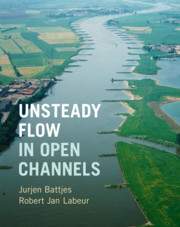Book contents
- Frontmatter
- Contents
- List of Symbols
- Preface
- 1 Basic Equations for LongWaves
- 2 Classification and Analysis of LongWaves
- 3 ElementaryWave Equation
- 4 TranslatoryWaves
- 5 Method of Characteristics
- 6 TidalBasins
- 7 HarmonicWave Propagation
- 8 FloodWaves in Rivers
- 9 SteadyFlow
- 10 Transport Processes
- 11 Numerical Computation of Solutions
- Appendix A Pressurized Flow in Closed Conduits
- Appendix B Summary of Formulas
- References
- Author Index
- Subject Index
9 - SteadyFlow
Published online by Cambridge University Press: 09 February 2017
- Frontmatter
- Contents
- List of Symbols
- Preface
- 1 Basic Equations for LongWaves
- 2 Classification and Analysis of LongWaves
- 3 ElementaryWave Equation
- 4 TranslatoryWaves
- 5 Method of Characteristics
- 6 TidalBasins
- 7 HarmonicWave Propagation
- 8 FloodWaves in Rivers
- 9 SteadyFlow
- 10 Transport Processes
- 11 Numerical Computation of Solutions
- Appendix A Pressurized Flow in Closed Conduits
- Appendix B Summary of Formulas
- References
- Author Index
- Subject Index
Summary
The preceding chapters have dealt with various types of long waves, in a sequence from rapidly varying translatory waves to slowly varying flood waves in lowland rivers, slow enough to be modelled as quasi-stationary. In the present chapter, we continue this line of development by considering steady flow. Within this class, we again deal with rapidly (spatially) varying flow first, in particular flow in control structures. This is followed by a section on gradually varying steady flow, the subject of the so-called backwater curves. Last, we deal with steady, uniform flow, mainly for a summary of expressions for flow resistance.
Rapidly Varying Flow
So far, we considered the propagation of various classes of long waves in canals, tidal channels and similar water courses, without obstructions of any kind. This no longer holds in cases where control structures are installed and operated, e.g. water intakes or weirs of various kinds for different functions such as
• discharge measurement
• control of discharge
• control of water level or flow depth.
From a hydrodynamics point of view, flows through or over a control structure belong to the category of rapidly varying flows, with length scales of the order of the flow depth. Because of these short scales, vertical accelerations are important, precluding the use of an assumption of hydrostatic pressure. The long-wave approach is locally not applicable.
Scaling Analysis
Up to a distance of a few depths upstream of a control structure, as well as beyond distances of some twenty flow depths downstream from it, the streamlines are more or less parallel, so that the long-wave approximation is applicable there. The structure determines the boundary conditions required for the calculation of these long waves. This is illustrated in Figure 9.1 for the case of a vertical, movable gate above a sill.
This chapter presents the key characteristic features of the flow in, over or through control structures, with respect to both the internal flow and the relations between the discharge and the water levels on either side.
- Type
- Chapter
- Information
- Unsteady Flow in Open Channels , pp. 157 - 184Publisher: Cambridge University PressPrint publication year: 2017

